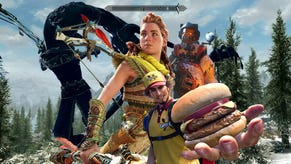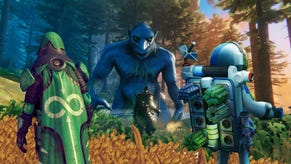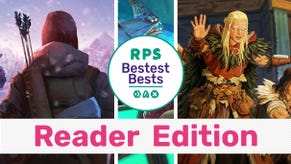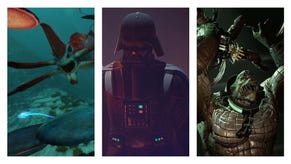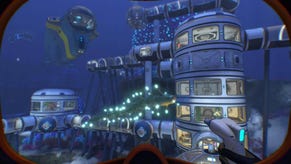State of the Art: The art of creating Subnautica's flora
Pond Life
If you've spoken to me for more than five minutes, chances are I've mentioned Subnautica [official site]. It's an open world survival game set largely underwater on an alien planet. You explore biomes, collect resources and, as updates to the early access project add more content, start to piece together the story of the planet. I played huge amounts of the game before more significant story elements were added and my big project was my volcano lair's garden. I collected all the weird and wonderful plants I could and cultivated them in little plant beds outside my underwater home. That's why, when I had a chance to speak with art director Cory Strader, I immediately wanted to talk about the game's flora.
Read on to find out how The Abyss, microscopy and a real fish with a transparent head and a visible brain all played their part! P.S. You can click on images to see larger version of the concept artwork or, if they're game screenshots, to just see them in isolation.
Pip: Hi Cory, can you tell me about how you started designing or conceptualising the look of Subnautica?
Cory Strader: From the beginning we wanted to make a non violent game, emphasizing the mystery of exploring a lush, alien underwater environment, that would appeal to gamers of all ages and types. I wanted a visual look that matched - a style that was approachable, colorful and fun, but with a darker edge, for the deeper and creepier biomes. The look is stylized to some degree, emphasising simple and slightly exaggerated silhouettes, without going too cartoony.
The references used for the look and feel of Subnautica are so varied and numerous it is hard to narrow down. Certainly the movie The Abyss was a big inspiration behind the game. Subnautica is like some mashup of The Abyss, Avatar, and Finding Nemo, in the way we tried to create a beautiful, vibrant and exotic world, in an underwater setting. It was important to have unique creatures and environments that are clearly alien, yet relatable and believable, therefore many real world references were closely studied to achieve the desired naturalistic look. I have folders filled with reference material of deep sea life and landscapes. Pictures of microscopy have also been great sources for alien textures and forms. Referencing the real world, as opposed to only looking at other games and movies that have come before, is key in developing designs that stand on their own.
Pip: The game separates its world out into different biomes, each with their own distinctive look. How did you keep them aesthetically distinct without feeling like they were from entirely different games or worlds?
Cory: This was certainly a challenge to pull off, and a credit to our level designers for achieving a level of cohesion throughout the entire world. And even now, in the polish phase they are going back into areas to smooth out some of the more abrupt transitions between biomes.
While we were conscious of maintaining consistency in the world, a fair amount just came about through necessity. As a smaller team with limited resources, there were only so many unique world textures, environment props, and creatures that we have been able to create. We often relied on only a handful of theme assets to give a biome it’s defining look. So, naturally to fill them out more, we had to incorporate generic plants and sand and rock textures used in many other areas, which automatically lent a consistency to the world as the player travels around.
Transitional zones and fog also play a large role in smoothing out the change from one world area to the next. We bordered the biomes with transitional “palette cleanser” sparse zones of mostly sand and rock, and also relied on extreme vertical dropoffs between areas. That, along with the pulled in viewing distance of the underwater fog, meant that the transition from one wildly different biome to the next happens more gradually, since you can rarely see the next biome from the one you currently occupy.
Pip: The first part of the world a player experiences, beyond the survival pod, is the shallows. My overall perception of the area is that it's bright and clear and has a lot of pink and purple as colour accents. How much of the effect of a bright and vibrant place comes from the colours of the objects themselves and how much is actually a result of how you use lighting and other techniques?
Cory: Bit of both, really. The terrain textures primarily use a combination of sand and light sedimentary rock, interspersed with patches of coral. We use a lot of grass, plant, and coral props which add pastel colors to the palette.
Then on the effects side, we use warm lighting and bright blue fog. It’s interesting because the fog distance is actually pushed out much further in some of the other biomes, but the perception of the Safe Shallows starting zone is that it is very clear water. The most predominant reason for this is the density of the detailing, and the very close horizon caused by the shallow seabed. Light rays and caustics visible on the ocean floor also contribute to the look of a bright and clear biome.
Pip: Looking at the plants in particular I'd be interested in how you approached them - how much were you basing them on real-world plants and how much was imagined?
Cory: Some of the more basic flora has a closer relationship to actual earth vegetation, such as the grass, seaweed, and coral branch filler assets. These help to quickly create layers of ground level detail and provide the impression of a lush underwater environment, or a tropical island for the above water biomes. The Kelp Forest biome in particular is very much based on kelp forests in the real world [browsing images of kelp forests is really relaxing - Pip], but tweaked to fit in the alien setting of Subnautica. The larger size of the kelp in the game, with their long undulating leaves, and large clusters of glowing orange seed pods give it the stylized and alien look.
But many of the plants in the game, especially the ones that define a biome’s look, are imagined. Real world references generally still play a part in the design, however, as the best fictional concepts always have some basis in reality in order to give them a degree of plausibility. But in some cases those references might be something seemingly unrelated. A good example of that would be the large, round, purple colored plants that fill one of the biomes - they were actually based off of rubber toy Koosh balls.
Pip: What is the process like when you're creating plants which also have a function as resources compared with the ones which are either ornamental or which the player can't even interact with as they're more like textures on objects? Do you have a different level or freedom, or is there more input from outside the art team for resource plants?
Cory: It was always important to Subnautica’s game designer, Charlie Cleveland, that the visual look of the biomes and their plantlife not be constrained by gameplay mechanics. So, for the most part we’ve had the freedom to design the plant life and many of the creatures as we see fit, and the gameplay is layered on top afterwards. The Creepvine kelp plants are probably one of the few exceptions, as those had been defined as a resource since the very first prototypes.
Pip: Given underwater flora and fauna can seem utterly alien, were there any real creatures or plants you found during your research which seemed particularly strange?
Cory: There are so many bizarre deep sea creatures that exist in Earth’s oceans, and new ones being discovered as we speak. I mean, there are fish with a transparent head, with eyes inside that can rotate all around!
It’s the reason why so many game and movie creature designs borrow heavily from existing ocean life. The challenge is trying to come up with creature designs that are unique and look more alien than, say, the Goblin sharks, Blobfish, and Anglerfish that exist on Earth.
Pip: There are some specific plants I loved seeing as I played so I was wondering if you could tell me more about what inspired you or how they developed:
1. Floating stones – I'd also love to know how these work as plants if you've given it much thought – are the orbs separate organisms from the roots/tendrils or is it all one and the same?
Cory: The name on these is a bit of a misnomer, as it refers to an earlier version of the concept design that had them looking more like stones then the gas filled pods they ended up as. We will likely change that before release.
The idea is that the gaseous orbs are part of the same organism as the roots, where the tendrils keep the buoyant pods anchored to the ground, as they grow from seed to spore. When they reach full maturity they burst, scattering the plant seeds out into the surrounding area, and perhaps even fertilizing the ground with dead fish caught in the explosion.
We originally intended that the pods would explode on contact with the player, serving as a natural minefield, that the player would need to carefully navigate through in their subs. However, this feature has not yet made it into the game, and likely never will.
2. The Membrain Tree
Cory: This design references the myriad of deep sea organisms which have a translucent outer membrane, in this case serving as a protective layer to the plants which grow inside the incubative structure. References of common coral and pine cones were also used in the design phase.
3. The Sea Crown
Cory: There wasn’t really a specific inspiration for this plant. In many cases the design approach relies on having already pored over a large amount of references materials, to the point where the visual language of what is going to convey an aquatic organism becomes almost second nature. Then it’s just a matter of doing a lot of quick thumbnail sketches to play with shapes and find interesting silhouettes. When a design seems to be working at that stage, it’s then taken further to find appropriate materials and colors, and refine the details. Since most of the plants did not come with specific gameplay requirements, there is a lot of creative freedom at the concept phase.
4. Tiger Plant – I like how meaty and angry this one looks, and how that sets it apart from most of the other plants. I'd be particularly interested in whether it was tricky to get the right effect and look for this one?
Cory: This is a rare example where we did go into the concept phase with a specific idea about a plant’s gameplay purpose, and it is one of the few dangerous plants in Subnautica. It is also a bit of a nod to our previous game, Natural Selection 2, which also had a ranged, spike shooting plant. Therefore, the shapes and colors used were very much form following function.
After a round of black and white thumbnail sketches trying out a variety of approaches I chose the one which had a good character to it, and potential for dynamic movement for it’s idle and attack animation. Several color and pattern schemes were tried.
The red and black striped version matched well with the warning colors that dangerous plants and creatures often employ as a defense mechanism in nature. The intention was that all of this combined - the chunky shapes with sharp spikes extending beyond the silhouette, the more active animations, and the bright red coloring - would make the plant more eye catching from a distance, and inform the player of potential danger. That, and all the spikes flying in their direction.
Pip: The Sea Crown data entry [you can find it on the Subnautica wiki] suggests you as a team have given thought to the genetics and commonalities of the plants so did you ever draw out a taxonomy?
Cory: We never drew out a taxonomy, and did not get too caught up in the science behind all of the plants, for several reasons. First, with a small team and limited resources, we really needed to put our focus and attention into the elements which had the most gameplay impact, and the plants are mainly just decoration.
Secondly, as mentioned earlier, we knew we would need to reuse a lot of the same plants throughout multiple biomes. There was little point to spending time figuring out which plants would realistically thrive in which environments, as the level designers just needed to have a pool of plant props to choose from when decorating their world areas. It was much simpler to just crank out a lot of really strange and unique plants, and place them based on what felt right and looked the best.
Pip: The bleached weirdness of the blood kelp caves was particularly striking when I visited for the first time and really creepy with the blood oil and the toes on the Ghost Weed and the fingers on Gabe's Feather. Was the horror/body part element always planned or did it come in gradually?
Cory: We knew we wanted to have some creepy biomes in the deeper parts of the world, but the horror/body element to Blood Kelp was pieced together gradually. It started with an image I had in my head of a sparse, ghostly version of the Kelp Forest biome, glowing eerily in the depths.
I did a quick painting of the plant that would define the look of the biome - pale, tall and spindly, with waving tentacles instead of leaves.
For added creepiness I made it carnivorous, with a small mouth-like opening at the very top that would feed on small fish, trapped by the surrounding tendrils. The deep red pustules that form near the base of the plants and on the giant roots that run underground in the caves add spots of color in the bleached environment, while also contributing to the horror feel.
We had already made The Ghost Weed and Gabe’s Feather plants before the Blood Kelp biome was designed, but they seemed to fit perfectly with the aesthetic. I then took a few creatures that we had in other biomes and did some paintovers to create variants in the horror style. As they were just texture re-skins and some slight model changes, it allowed us to quickly add new fauna to the zone, without having to re-rig, animate, and code completely new creatures.
Pip: I think there are a couple of plants still to be implemented in the game so could you tell me anything about those?
Cory: At the moment we don’t have any plans to add more plants than are currently in the game for release. However, there are some ideas we’d love to implement for content after 1.0 ships. I have a biome concept I made some time ago of some floating rock islands being suspended by giant lily pads that would be fun to have in the game. However at this time we can’t make any promises in regards to new content and features after release.
Pip: Are there any gaps in the flora that you'd like to plug, either in terms of their function as resources in the game or just as decoration you feel would benefit any of the biomes?
Cory: Sure, if we had more time, and if we weren’t as constrained by engine limitations, I’d love to have a wider variety of unique plants so that we wouldn’t have to re-use as many from the current set. But, what I’d really love, is to be able to give more gameplay use and function to the existing decorative plants that are already in the game.
Pip: Which is your favourite biome and why?
Cory: Hmm... this is like trying to name my favorite child. They all have their own personalities and aspects which make them special in some way. Safe Shallows is always going to have a special place in my heart, as it’s the first area we really developed out and I think it’s what people picture the most when thinking about Subnautica. It’s bright, peaceful, with a nice distribution of detail, and the interplay between the water surface and underwater areas is really nice.
My other favorite biome is definitely Lost River. It’s wonderfully creepy, with the poisonous brine pools, which are an actual real world phenomena, creating a bizarre water under the water look, out of which protrude the skeletons of ancient, massive creatures.. It is one of the biggest biomes and probably has the most unique assets of any, so it really has a lot of detail and variation throughout.
Pip: Thank you for your time!
Subnautica is out now in Early Access for £14.99 - as per any Early Access game all the usual caveats apply and you should only invest if you'd be happy if the game never went any further etc etc etc etc etc




















